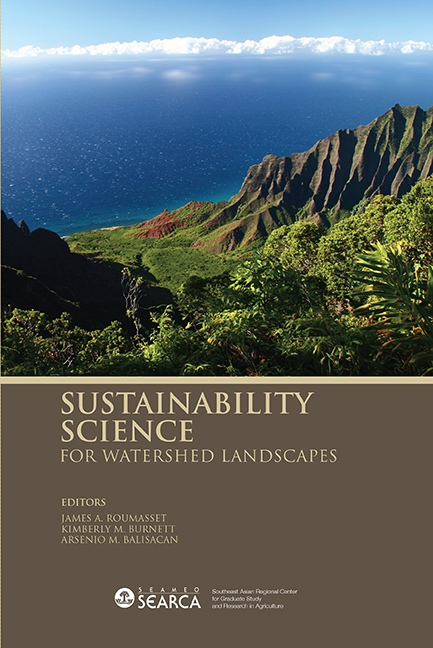Book contents
- Frontmatter
- Contents
- Tables
- Figures
- Message
- Foreword
- Preface
- Acknowledgments
- List of Contributors
- Theme 1 Sustainability Science for Resource Management and Policy
- Theme 2 Monitoring and Modelling
- 5 Cyberinfrastructure for Sustainability in Coupled Human – Environment Systems
- 6 Watershed Management for Sustainability in Tropical Watersheds: An Integrated Hydrologic Modelling Approach
- 7 Watershed Assessment, Restoration, and Protection in Hawaiʿi
- Theme 3 Participatory Approaches
- Theme 4 Case Studies
- Synthesis
6 - Watershed Management for Sustainability in Tropical Watersheds: An Integrated Hydrologic Modelling Approach
from Theme 2 - Monitoring and Modelling
Published online by Cambridge University Press: 21 October 2015
- Frontmatter
- Contents
- Tables
- Figures
- Message
- Foreword
- Preface
- Acknowledgments
- List of Contributors
- Theme 1 Sustainability Science for Resource Management and Policy
- Theme 2 Monitoring and Modelling
- 5 Cyberinfrastructure for Sustainability in Coupled Human – Environment Systems
- 6 Watershed Management for Sustainability in Tropical Watersheds: An Integrated Hydrologic Modelling Approach
- 7 Watershed Assessment, Restoration, and Protection in Hawaiʿi
- Theme 3 Participatory Approaches
- Theme 4 Case Studies
- Synthesis
Summary
ABSTRACT
Competition for natural resources between various stakeholders within the same geographical area is becoming a reality. An integrated, multidisciplinary modeling approach is needed to efficiently manage these resources. A watershed management approach, using hydrologic modeling, enjoys ample acceptance in coastal areas and small islands because of the smallsized watersheds in these areas. Water quality and quantity are essential parts of the livelihood of these areas. A deep understanding of watershed hydrology and water quality is necessary for sustainable planning, management, and protection of natural resources. Hydrologic models offer practical tools for watershed management as they optimise two precious assets – time and money. These models lessen the number of field experiments required to implement and underscore major parameters and variables that most influence this system.
This chapter summarises the results of evaluating the performance of AnnAGNPS (Annualised Agricultural Nonpoint Source Pollution) and N-SPECT (Nonpoint Source Pollution and Erosion Comparison Tool) under tropical and coastal watershed settings. The models identified “hotspots” to be targeted to enhance watershed sustainability. The models were found to have strong potential in simulating the runoff and sediment load from the Hanalei River Basin in Kauaʿi, Hawaiʿi. However, these models need to be improved to make their predictions and capabilities in watersheds of steep slope and spatially variable rainfall more precise.
INTRODUCTION
Rapid growth of global population and changes in economic environments trigger land-use change that can be linked to changes in climate, biodiversity, and water quantity and quality. The impacts of these changes have more pronounced effects on coastal watersheds, especially those of small islands, i.e. Caribbean, Pacific, and the Hawaiian Islands. The concept of watershed sustainability originated from attempts to manage renewable resources by measuring annual increases in resources without reducing physical stocks (Dixon and Fallon 1989). Collaborative watershed planning and management, with the help of local groups and institutions, is a solution to developing sustainable programmes in a watershed.
- Type
- Chapter
- Information
- Sustainability Science for Watershed Landscapes , pp. 141 - 166Publisher: ISEAS–Yusof Ishak InstitutePrint publication year: 2010



